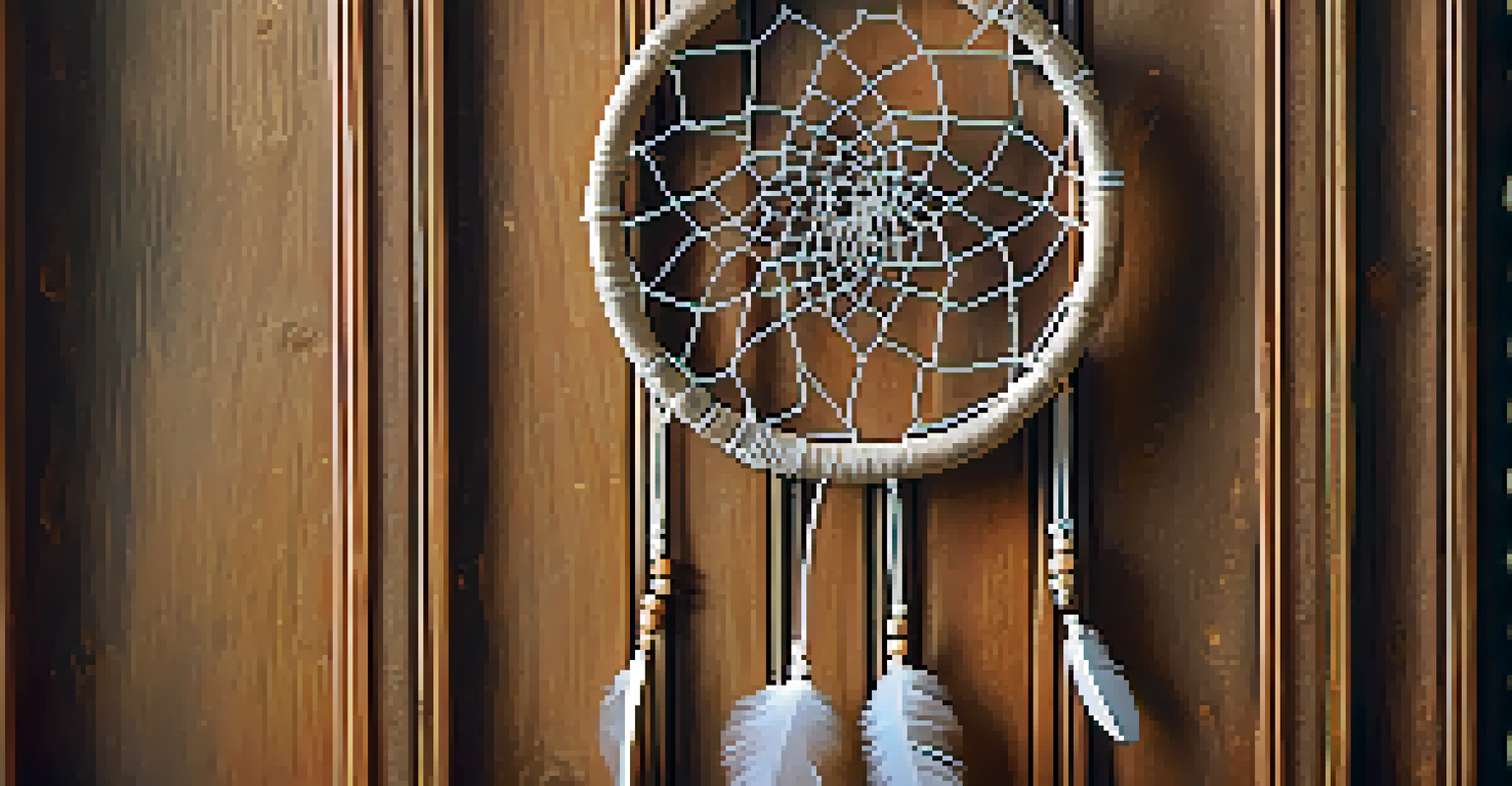Exploring the Use of Symbolism in Indigenous Spiritual Art

Understanding Symbolism in Indigenous Cultures
Symbolism plays a crucial role in Indigenous cultures, serving as a bridge between the material and spiritual worlds. Each symbol is often deeply rooted in the community's history, beliefs, and natural surroundings. For instance, animals might represent various traits, such as the eagle symbolizing vision and strength, while plants can embody healing and sustenance.
Art is a way of recognizing ourselves in the world and in each other, a way of expressing our shared humanity.
These symbols are not just artistic choices; they reflect the values and teachings passed down through generations. When observing Indigenous art, it's essential to recognize that every element carries significance, much like how a family crest tells the story of a lineage. This layered meaning invites viewers to engage more profoundly with the artwork.
By understanding the symbolism, one can appreciate the cultural narratives woven into the art. It transforms the experience from mere observation to a meaningful dialogue with the traditions and beliefs of Indigenous peoples.
Common Symbols and Their Meanings
Many symbols recur in Indigenous spiritual art, each packed with meaning. For example, the circle is a prevalent motif representing unity, wholeness, and the cyclical nature of life. This concept of circles can be seen in various forms, from dreamcatchers to paintings, emphasizing the interconnectedness of all beings.

Another common symbol is the spiral, which often signifies growth and evolution. It can represent a journey, reflecting the idea that life is not linear but rather a series of experiences that lead to personal development. Such symbols encourage reflection on one's path and the lessons learned along the way.
Symbolism Links Art and Culture
Indigenous symbols serve as a bridge between material and spiritual worlds, reflecting the community's history and beliefs.
Understanding these symbols adds depth to the appreciation of Indigenous art. Each piece becomes a window into the community’s worldview, offering insights into their spiritual beliefs and cultural practices.
The Role of Nature in Symbolic Representation
Nature serves as a profound source of inspiration in Indigenous spiritual art, with many symbols derived from the natural world. Elements such as water, earth, fire, and air are not just physical components but also embody spiritual significance. For instance, water often symbolizes life and cleansing, while earth represents grounding and stability.
The purpose of art is not a rarified, intellectual distillate; it is life, intensified, and its range is as limitless as human life itself.
Artists frequently incorporate these natural symbols to reflect their connection to the environment. This relationship is evident in works that depict landscapes or animals, emphasizing respect and gratitude towards nature. The use of these symbols fosters a sense of belonging within the larger ecosystem.
By grounding their art in nature, Indigenous artists highlight the importance of environmental stewardship. Their work serves as a reminder of the responsibility to protect and honor the natural world, reinforcing the idea that all life is interconnected.
Spiritual Practices Reflected in Art
Indigenous spiritual art often serves as a medium for expressing beliefs and practices. Rituals, ceremonies, and storytelling are common themes, with symbols acting as visual representations of these practices. For example, masks used in ceremonies can symbolize transformation, connecting the physical wearer to the spiritual realm.
Through art, these practices are not only preserved but also shared with broader audiences. When art is created for ceremonies, it becomes a living expression of spirituality, inviting viewers to witness and participate in the cultural narrative. This sharing fosters a deeper understanding and appreciation for Indigenous spirituality.
Nature Inspires Indigenous Art
Elements from the natural world are infused into art, highlighting the connection between Indigenous cultures and their environment.
As viewers engage with this art, they are encouraged to reflect on their spirituality and beliefs. The connection between art and spiritual practices creates a dialogue that transcends cultural boundaries and fosters mutual respect.
Modern Interpretations of Traditional Symbols
In contemporary Indigenous art, traditional symbols are often reinterpreted to address modern issues. Artists merge age-old motifs with current themes, creating a dialogue between the past and the present. This evolution of symbolism allows for a fresh perspective while honoring cultural heritage.
For example, an artist might use traditional designs to comment on environmental issues, blending ancient wisdom with contemporary challenges. This fusion not only revitalizes the art form but also highlights the ongoing relevance of Indigenous perspectives in today’s world.
By embracing both tradition and modernity, these artists ensure that their cultural narratives remain dynamic and relevant. This approach invites broader audiences to engage with Indigenous art, fostering appreciation and understanding across generations.
Art as a Tool for Cultural Preservation
Indigenous spiritual art serves as a vital tool for preserving culture and history. Through visual storytelling, artists communicate the values, beliefs, and experiences of their communities. This preservation is crucial, especially in the face of globalization, which can threaten the survival of unique cultural identities.
By creating art that reflects their heritage, Indigenous artists contribute to the revival and maintenance of traditional practices. This effort not only honors past generations but also inspires future ones to embrace their roots and continue the cultural legacy.
Art Preserves and Shares Heritage
Indigenous spiritual art acts as a vital tool for cultural preservation, allowing communities to communicate their values and stories.
Art becomes a vessel for education, allowing both Indigenous and non-Indigenous individuals to learn about and appreciate diverse cultures. Through this sharing of knowledge, the art fosters respect and understanding, bridging cultural divides.
The Impact of Symbolism on Audience Engagement
The symbolism within Indigenous spiritual art plays a significant role in how audiences engage with the artwork. When viewers recognize and understand the meanings behind symbols, they develop a deeper connection to the piece and its cultural context. This engagement transforms passive observation into active participation.
For instance, a viewer familiar with the symbolism of the eagle may feel a sense of empowerment and inspiration when encountering an artwork featuring this powerful bird. This emotional response highlights the potential of art to evoke feelings and provoke thought, making it a potent medium for cultural expression.

Ultimately, the power of symbolism lies in its ability to resonate with people on various levels. By fostering this connection, Indigenous art not only tells a story but also encourages empathy and understanding across different cultures.